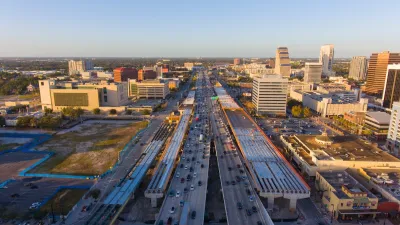The NYT is reporting that New Jersey is running out of developable land, but with the recent ARC decision, the legacy of the Mount Laurel doctrine, and decades of highway-based suburbanizing policies, is New Jersey actually ready for density?
New Jersey has always been an odd state – it's the most densely populated of the fifty, and yet it lies just outside of the core of both of its metro areas (Philadelphia and New York). North Jersey does have a formidable number of mid-sized cities, but the biggest – Newark - is a poster child for urban neglect, and New Jersey's urban areas play a tepid second fiddle to their much larger counterparts across the Delaware and the Hudson. New Jersey's appeal lies undeniably in its suburbs, which are connected by a network of government-built roads and enabled by anti-density development rules.
Despite New Jersey's predilection for sprawl, the New York Times reports that the state may literally be running out of horizontal space. A Rutgers study claims that around the middle of the 21st century New Jersey will become the first state to develop all its unprotected land development trends remain unchanged.
Thanks to Stephen Smith
FULL STORY: When will New Jersey end its sprawling ways?

Study: Maui’s Plan to Convert Vacation Rentals to Long-Term Housing Could Cause Nearly $1 Billion Economic Loss
The plan would reduce visitor accommodation by 25,% resulting in 1,900 jobs lost.

Alabama: Trump Terminates Settlements for Black Communities Harmed By Raw Sewage
Trump deemed the landmark civil rights agreement “illegal DEI and environmental justice policy.”

North Texas Transit Leaders Tout Benefits of TOD for Growing Region
At a summit focused on transit-oriented development, policymakers discussed how North Texas’ expanded light rail system can serve as a tool for economic growth.

Why Housing Costs More to Build in California Than in Texas
Hard costs like labor and materials combined with ‘soft’ costs such as permitting make building in the San Francisco Bay Area almost three times as costly as in Texas cities.

San Diego County Sees a Rise in Urban Coyotes
San Diego County experiences a rise in urban coyotes, as sightings become prevalent throughout its urban neighbourhoods and surrounding areas.

Los Angeles County Invests in Wildfire Recovery for Parks, Trails, and Open Space
The $4.25 million RESTORE Program supports the recovery of parks, trails, and open spaces damaged by the January 2025 wildfires through targeted grants that promote community healing, wildfire resilience, and equitable access to nature.
Urban Design for Planners 1: Software Tools
This six-course series explores essential urban design concepts using open source software and equips planners with the tools they need to participate fully in the urban design process.
Planning for Universal Design
Learn the tools for implementing Universal Design in planning regulations.
Smith Gee Studio
Alamo Area Metropolitan Planning Organization
City of Santa Clarita
Institute for Housing and Urban Development Studies (IHS)
City of Grandview
Harvard GSD Executive Education
Toledo-Lucas County Plan Commissions
Salt Lake City
NYU Wagner Graduate School of Public Service



























